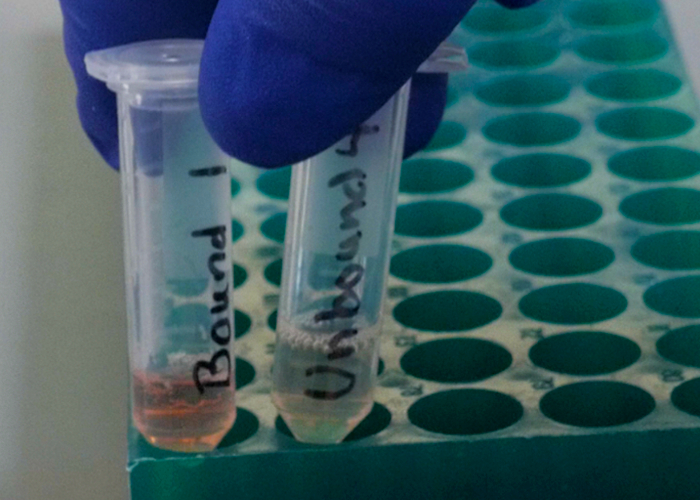이온 교환 크로마토그래피
Overview
출처: 박사의 실험실.B 질 벤턴 - 버지니아 대학
이온 교환 크로마토그래피는 충전에 따라 문체를 분리하는 크로마토그래피의 한 유형입니다. 이온 교환 수지라고 하는 솔리드 지지대에서 충전된 고정 단계로 채워진 열이 사용됩니다. 강력한 양이온 교환 크로마토그래피는 음전하 수지를 사용하여 양이온을 우선적으로 분리하고 강력한 음이온 교환 크로마토그래피는 양전하 수지를 사용하여 음이온을 우선적으로 선택합니다. 크롬 토그래피의 이 모형은 단백질 또는 핵산 견본의 정화에서 예를 들면 견본 준비를 위해, 예를 들면 인기 있습니다.
이온 교환 크로마토그래피는 2단계 과정입니다. 첫 번째 단계에서 샘플은 로딩 버퍼의 열에 로드됩니다. 컬럼 수지에 충전된 샘플의 바인딩은 반대 전하의 샘플을 유치하기 위해 수지의 이온 상호 작용을 기반으로 합니다. 따라서, 수지에 반대 극성의 충전 된 샘플은 강하게 결합된다. 충전되지 않거나 반대 전하인 다른 분자는 결합되지 않으며 열을 통해 세척됩니다. 두 번째 단계는 수지에 바인딩된 별무를 엘로우트하는 것입니다. 이것은 완충제의 소금 양이 천천히 증가하는 소금 그라데이션으로 수행됩니다. 분수는 용출이 발생하고 이러한 분획 중 하나에서 정제 된 관심 샘플을 복구 할 수 있습니다으로 컬럼의 끝에 수집됩니다. 분광법과 같은 또 다른 기술은 샘플을 포함하는 분획을 식별하기 위해 필요할 수 있습니다. 이온 교환 크로마토그래피는 단백질 연구에서 특히 유용하며, 크기가 수지와의 상호 작용 수를 결정할 수 있으므로 특정 충전 또는 크기가 있는 관심 있는 단백질을 분리하는 데 특히 유용합니다.
이온 교환 크로마토그래피는 친화성 크로마토그래피보다 일반적인 분리 기술이며, 이는 항체가 하나의 특정 문체를 결합하기 위해 컬럼에 부착되는 단백질 샘플을 준비하는 데 자주 사용된다. 각 별무에 대해 새로운 친화성 컬럼을 구입해야 하며, 동일한 유형의 이온 교환 컬럼을 사용하여 동일한 충전의 많은 단백질을 정리하는 데 사용할 수 있습니다. 이온 교환 크로마토그래피는 다른 특성에 따라 분리되는 다른 유형의 크로마토그래피와 함께 사용할 수도 있습니다. 예를 들어 크기 배제 크로마토그래피는 크기에 따라 구분되며 이온 교환 크로마토그래피 전에 지정된 크기의 화합물만 선택하도록 사용할 수 있습니다.
Procedure
1. 샘플 및 열 준비
- 이 데모에서, 2 단백질의 혼합물은 양이온 교환 컬럼에 분리될 것이다: 헤모글로빈과 사이토크롬 C. 단백질 샘플및 소용돌이에 0.2 mL 평형 버퍼(pH 8.1)를 추가하여 철저히 섞는다. 2 분 동안 원심 분리기는 거품을 제거합니다.
- 수지침이 정착할 수 있도록 5분 동안 시험관에 양이온 교환 컬럼을 놓습니다. 테스트 튜브를 링 스탠드에 컬럼으로 고정하여 똑바로 세워 있는지 확인합니다.
- 열의 위쪽 캡을 열고 아래쪽 캡을 엽니다. 컬럼의 버퍼가 중력 하에서 테스트 튜브로 흘러 내도록 합니다.
- 열 볼륨(이 경우 열 볼륨은 0.3 mL)으로 열을 평형 버퍼로 두 번 세척합니다. 평형 버퍼의 첫 번째 열 부피(0.3 mL)가 두 번째 열 볼륨을 추가하기 전에 폐기물 바이알에 드립하게 합니다. 이 단계를 사용하면 열이 평형 버퍼와 일치할 수 있습니다. 이 단계에서 계피 버퍼를 천천히 추가하여 수지를 방해하지 않습니다.
Application and Summary
이온 교환 크로마토그래피는 단백질 샘플을 분리하고 정화하기 위해 생화학에 널리 사용됩니다. 단백질에는 충전되는 기능성 그룹이 있는 많은 아미노산이 있습니다. 단백질은 pH에 의존하는 순 전하에 따라 분리됩니다. 몇몇 단백질은 그 외가 더 부정적으로 충전되는 동안 더 긍정적으로 충전됩니다. 또한, 펩티드 태그는 단백질에 유전적으로 첨가되어 정상 단백질의 범위에 있지 않은 등산지점...
Tags
건너뛰기...
이 컬렉션의 비디오:

Now Playing
이온 교환 크로마토그래피
Analytical Chemistry
265.1K Views

분석 특성화를 위한 샘플 준비
Analytical Chemistry
85.2K Views

내부 표준
Analytical Chemistry
205.4K Views

표준 추가 방법
Analytical Chemistry
320.7K Views

교정 곡선
Analytical Chemistry
798.6K Views

자외선 눈에 보이는 (UV-Vis) 분광법
Analytical Chemistry
625.2K Views

화학 분석을 위한 라만 분광법
Analytical Chemistry
51.4K Views

엑스레이 형광 (XRF)
Analytical Chemistry
25.9K Views

화염 이온화 감지를 갖춘 가스 크로마토그래피(GC)
Analytical Chemistry
283.0K Views

고성능 액체 크로마토그래피 (HPLC)
Analytical Chemistry
385.9K Views

모세관 전기 포레시스 (CE)
Analytical Chemistry
94.5K Views

질량 분광법 소개
Analytical Chemistry
112.9K Views

스캐닝 전자 현미경 검사법 (SEM)
Analytical Chemistry
87.6K Views

전위요스타트/갈바노스타트를 사용하여 지원되는 촉매의 전기화학적 측정
Analytical Chemistry
51.8K Views

순환 볼탐량 (CV)
Analytical Chemistry
125.9K Views
Copyright © 2025 MyJoVE Corporation. 판권 소유
